SAB4200692
Anti-Glutathione-S-Transferase (GST) antibody, Mouse monoclonal
clone GST-2, purified from hybridoma cell culture
Sinónimos:
GST, Glutathione-S-Transferase
Seleccione un Tamaño
385,70 €
Precio de catálogo551,00 €Ahorre 30 %Seleccione un Tamaño
About This Item
385,70 €
Precio de catálogo551,00 €Ahorre 30 %Productos recomendados
origen biológico
mouse
Nivel de calidad
forma del anticuerpo
purified immunoglobulin
tipo de anticuerpo
primary antibodies
clon
GST-2, monoclonal
Formulario
buffered aqueous solution
concentración
~1 mg/mL
técnicas
ELISA: suitable
dot blot: suitable
immunoblotting: 0.5 μg/mL
immunofluorescence: suitable
immunoprecipitation (IP): suitable
isotipo
IgG2b
Condiciones de envío
dry ice
temp. de almacenamiento
−20°C
modificación del objetivo postraduccional
unmodified
Descripción general
Inmunógeno
Aplicación
- immunoblotting
- immunoprecipitation
- dot blotting
- autoradiography
- immunofluorescence
- enzyme-linked immunosorbent assay (ELISA)
Acciones bioquímicas o fisiológicas
Forma física
Cláusula de descargo de responsabilidad
¿No encuentra el producto adecuado?
Pruebe nuestro Herramienta de selección de productos.
Código de clase de almacenamiento
10 - Combustible liquids
Clase de riesgo para el agua (WGK)
WGK 1
Punto de inflamabilidad (°F)
Not applicable
Punto de inflamabilidad (°C)
Not applicable
Elija entre una de las versiones más recientes:
Certificados de análisis (COA)
¿No ve la versión correcta?
Si necesita una versión concreta, puede buscar un certificado específico por el número de lote.
¿Ya tiene este producto?
Encuentre la documentación para los productos que ha comprado recientemente en la Biblioteca de documentos.
Los clientes también vieron
Filtros activos
Nuestro equipo de científicos tiene experiencia en todas las áreas de investigación: Ciencias de la vida, Ciencia de los materiales, Síntesis química, Cromatografía, Analítica y muchas otras.
Póngase en contacto con el Servicio técnico





